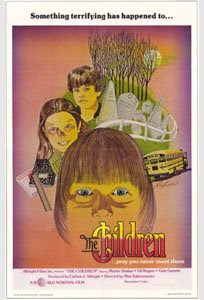
Taking a straight-forward approach, Alan B. McElroy's Halloween 4 script (delivered under the gun of a writer's strike) is respectful towards the first film, eschewing II's attempts to explain Michael's supernatural abilities through the myth of Samhain (as in the first film, Michael is now simply regarded as Evil incarnate with no arcane explanations necessary) and director Dwight H. Little creates an efficiently scary mood, evoking the dark autumnal menace of the original with the proper Midwestern ambience (and composer Alan Howarth effectively reprises the famous Halloween theme). With Jamie Lee Curtis having gone on to A-list projects by this time, her character of Laurie Strode was written out of the new film (dead in a car crash, we're told) leaving a young daughter in her wake. In tribute to Curtis, her onscreen daughter is named Jamie (played by the appealing Danielle Harris) and Jamie lives in the care of her adopted family, the Carruthers, which includes an older sister named Rachel (Ellie Cornell).
While a comatose Michael is being transported from the sanitarium that he's been incarcerated in for the last ten years (this move is being attempted, of course, during a thunderstorm on the eve of Halloween - how about a pat on the back for whoever planned this fiasco!) an ambulance attendant who clearly takes his life for granted carelessly lets slip in Michael's presence that Michael has a niece alive and well back home. Mad Mike immediately emerges from his catatonia and does what he does best, slaughtering the ambulance crew. With Michael loose again, it's up to Dr. Loomis (the returning Donald Pleasence) to hunt down his old quarry. Given that Michael is famous for his one track mind, Loomis doesn't waste any time heading to Haddonfield.
As Loomis tries to stop Michael from reprising his rampage of ten years ago, Halloween 4 quickly reveals itself as an amped-up remake of the first film only now instead of Donald Pleasence simply crouching in the bushes with Charles Cyphers scaring kids away from the Myers' house, Loomis has some real back-up in place. Which is good, because Michael is pressing his attack harder than ever this time around. On the way to Halloween 4's climatic face-off, Little delivers several well-conceived action scenes, including an extended roof top chase and an attack on a speeding pick up truck. While some may feel scenes like these take some of the Boogeyman element out of Michael, there's still a number of moody scares to be found - in fact, Little stages one of the creepiest kills in the entire series featuring a bit of misdirection involving a rocking chair and a cop on late watch against Michael.
As much as this was billed as the Return of Michael Myers, this was also the Return of Loomis. Unlike Jason and Freddy, who squared off against succeeding rounds of disposable teen opponents, the Halloween series was always distinguished by Loomis' Ahab-like pursuit of Michael. Ever since Loomis uttered the lines "He's escaped! The Evil has escaped!", the chase was on and much of the appeal of the series lay in Pleasence's comfortingly hammy portrayal of Loomis. Having Loomis around to describe Michael as evil on two legs is what made Michael more than just a thug with a knife. This wasn't Charles Durning chasing Tony Beckley in When A Stranger Calls. You'd never hear Loomis talk about Michael in psychiatrict terms. From Day 1 Loomis was trying to send Evil Itself back to Hell - an element that turned what could've been mean-spirited set of films into something more akin to classic monster movies with Loomis serving as a determined Van Helsing. If the makers of Halloween 4 deserve credit for anything, it's for bringing Loomis back, when it would've been easy to just have let the character go.
Like most sequels, Halloween 4 is largely a middle-of-the-road effort but in an age where most horror franchises now revolve around unlikable characters subjected to extreme torture (the current success of Saw V proving that this trend is far from over) and when even the Halloween series itself has taken an ugly turn (thanks, Rob Zombie!) it's worth appreciating what Halloween 4 represents - a time when even horror's heavyweights didn't have to be such jaded enterprises to prove their credibility.
























